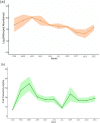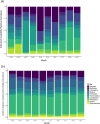Dietary preferences and feeding strategies of Colombian highland woolly monkeys
- PMID: 35999220
- PMCID: PMC9399098
- DOI: 10.1038/s41598-022-17655-5
Dietary preferences and feeding strategies of Colombian highland woolly monkeys
Abstract
Primates are very selective in the foods they include in their diets with foraging strategies that respond to spatial and temporal changes in resource availability, distribution and quality. Colombian woolly monkeys (Lagothrix lagotricha lugens), one of the largest primate species in the Americas, feed mainly on fruits, but they also eat a high percentage of arthropods. This differs from closely related Atelid species that supplement their diet with leaves. In an 11 month study, we investigated the foraging strategies of this endemic monkey and assessed how resource availability affects dietary selection. Using behavioural, phenological, arthropod sampling and metabarcoding methods, we recorded respectively foraging time, forest productivity, arthropod availability in the forest and arthropod consumption. Scat samples and capturing canopy substrates (i.e. moss, bromeliads, aerial insects) were used for assigning arthropod taxonomy. The most important resource in the diet was fruits (54%), followed by arthropods (28%). Resource availability predicted feeding time for arthropods but not for fruits. Further, there was a positive relationship between feeding time on fruits and arthropods, suggesting that eating both resources during the same periods might work as an optimal strategy to maximize nutrient intake. Woolly monkeys preferred and avoided some fruit and arthropod items available in their home range, choosing a wide variety of arthropods. Geometrid moths (Lepidoptera) were the most important and consistent insects eaten over time. We found no differences in the type of arthropods adults and juveniles ate, but adults invested more time foraging for this resource, especially in moss. Although woolly monkeys are generalist foragers, they do not select their food items randomly or opportunistically.
© 2022. The Author(s).
Conflict of interest statement
The authors declare no competing interests.
Figures




References
-
- Garber PA. Foraging strategies among living primates. Annu. Rev. Anthropol. 1987;16:339–364. doi: 10.1146/annurev.an.16.100187.002011. - DOI
-
- Stephens DW, Krebs JK. Foraging Theory. Princeton University Press; 1987.
-
- Felton AM, et al. Nutritional ecology of Ateles chamek in lowland Bolivia: How macronutrient balancing influences food choices. Int. J. Primatol. 2009;30:675–696. doi: 10.1007/s10764-009-9367-9. - DOI
-
- Marshall AJ, Wrangham RW. Evolutionary consequences of fallback foods. Int. J. Primatol. 2007;28:1219–1235. doi: 10.1007/s10764-007-9218-5. - DOI
Publication types
MeSH terms
LinkOut - more resources
Full Text Sources
Research Materials

